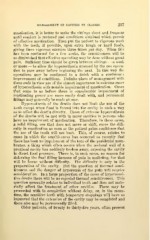Page 355 - My FlipBook
P. 355
MANAGEMENT OF CAVITIES BY CLASSES. 217
mastication, it is better to make the sittings short and frequent
until comfort is restored and conditions obtained which permit
of effective mastication. Then put the patient to vigorous work
with the teeth, if possible, upon extra tough or hard foods,
giving them vigorous exercise three times per day. When this
has been continued for a few weeks, the sensitiveness will be
so diminished that effective operating may be done without great
pain. Sufficient time should be given between sittings — a week
or more— to allow the hyperesthesia aroused by the one opera-
tion to pass away before beginning the next. In this way the
operations may be continued to a finish with a continuous
improvement of conditions. Definite plans of management with
these ends in view are of the utmost importance in extreme cases
of hyperesthesia with notable impairment of mastication. Cases
that come to us before there is considerable impairment of
masticating power are more easily dealt with, and permanent
fillings may generally be made at once.
Hyperesthesia of the dentin does not limit the use of the
teeth except when food is forced into the cavity in such a way
as to affect the dentin directly. Cases of extreme hyperesthesia
of the dentin will be met with in many cavities in persons who
have no impairment of mastication. Therefore, in these cases,
a solid filling, one that does not move or shift, cures the diffi-
culty in mastication as soon as the patient gains confidence that
the use of the tooth will not hurt. This, of course, relates to
cases in which the sensitiveness has occurred so recently that
there has been no impairment of the tone of the peridental mem-
branes, a thing which often occurs when the occlusal wall of a
proximal cavity has suddenly broken away, exposing the cavity
to direct food pressure. There is, in such cases, no reason for
deferring the final filling because of pain in malleting, for that
will be borne without difficulty. The difficulty is only in the
preparation of the cavity. But the question of thermal sensi-
tiveness and the danger of hyperemia of the pulp will require
consideration. In a large proportion of the cases of hypersensi-
tive dentin there will be no especial thermal sensitiveness. This
question generally relates to individual teeth and does not mate-
rially affect the treatment of other cavities. These may be
proceeded with to completion without delay, or, in the mean-
time, the sensitive teeth with temporary stoppings will have so
improved that the extension of the cavity may be completed and
these also may be permanently filled.
Older patients, of twenty to thirty-five years, often present


